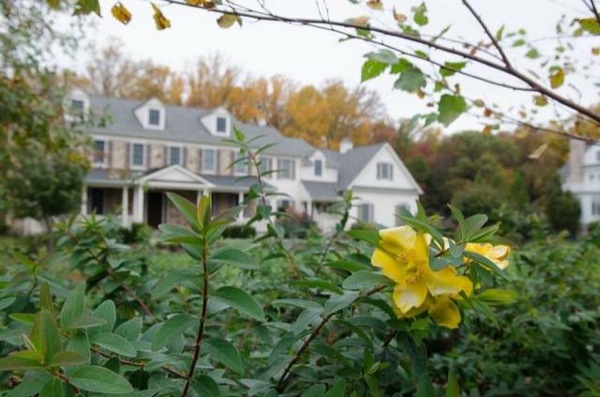
Native Delaware: Garden variety
'Earth Perfect?' symposium to take place at UD, area gardens June 6-9
11:10 a.m., May 28, 2013--Annette Giesecke is a professor of classics and chair of the ancient Greek and Roman studies department at the University of Delaware She also is the mastermind behind “Earth Perfect? Nature, Utopia, and the Garden,” a June 6-9 symposium taking place at UD and several local horticulture venues.
It may seem unusual for a professor of classics to organize a horticulture symposium. But this isn’t a garden-variety garden conference. If you’re only looking for tips on pruning or growing the perfect tomato, you’ve come to the wrong place.
Campus Stories
From graduates, faculty
Doctoral hooding
“’Earth Perfect?’ will showcase the garden as an emblem of the ideal human relation with nature,” says Giesecke. “Anybody who is interested in the importance and meaning of gardens, and the politics of gardens, will want to attend. It’s not just an event for academics and garden professionals.”
Frankly, even those of us who never stopped to think about the meaning of gardens – we just know we like them -- may find the symposium worthwhile. The eclectic program includes a lecture by UD professor McKay Jenkins on the environmental and health risks of lawn chemicals. There’s a workshop on creating “night spaces” and another on designing with edible plants. You can learn about slave gardens in the antebellum South or contemporary urban vertical farms.
Keynote speakers include Emma Marris, author of Rambunctious Garden: Saving Nature in a Post-Wild World, and UD’s Doug Tallamy, author of Bringing Nature Home: How You Can Sustain Wildlife with Native Plants. Mixed in with the lectures and workshops are special tours of Winterthur, Longwood Gardens, Chanticleer and the Mt. Cuba Center.
Giesecke, who has written widely about the gardens of ancient Greek and Rome, was inspired to create the symposium after co-editing a publication also called Earth Perfect? Nature, Utopia and the Garden.
Sue Barton, an ornamental horticulture specialist with UD Cooperative Extension, is excited to be speaking at the symposium because she wants to get more people thinking and talking about her lecture topic -- livable ecosystems as a model for suburbia.
What’s a livable ecosystem?
The easiest way to explain it is to say what it’s not – a livable ecosystem isn’t a chemically treated monoculture of turfgrass with a few non-native, invasive trees plunked down in the front yard, too far from the house to shade it in summer or serve as a windbreak in winter.
In other words, a livable ecosystem is a far cry from what many suburban yards look like today.
“The traditional home landscape contains a limited palette of plants, has large areas of regularly mowed lawn, and provides relatively few ecosystem services,” says Barton. “Forests and meadows, on the other hand, provide many ecosystem services.”
Rest assured, you don’t need to remove every blade of grass and turn your yard into a jungle to create a livable ecosystem.
Take, for example, the attractive new landscape at a home in the Applecross neighborhood off Route 100 in Greenville. It does look a bit different than the neighbors’ yards – for one thing, there’s a 6,000-square-foot meadow of native grasses. It also features a newly reforested area, adjoining an existing wooded tract. Invasive plants have been removed and replaced by white oaks, blueberry bushes, ornamental grasses and other native species.
Grass plays a role, too, but it’s been bumped from star of the show to a member of the supporting cast.
“Turf on the property is used purposefully, for recreation areas, circulation, or as the green carpet that sets off other plantings,” says Barton.
The yard is part of a UD research project on livable ecosystems. “We want to see if replacing the typical suburban yard of mostly grass with one containing diverse vegetation can help protect the environment and make landscapes more sustainable,” she says.
The Applecross property is one aspect of a multidisciplinary project involving five UD faculty members and dozens of undergraduate and grad students. Another research site is located at Winterthur, where the UD team is collecting water quality data in three streams that drain from three different landscapes – mowed lawn, meadow, and forest. They’re also collecting data on the diversity of plants, insects and birds in each of these settings.
If you won’t have a chance to hear Barton at the Earth Perfect symposium, you’ll have a second chance on June 14, at a Sustainable Landscape Tour. Sponsored by UD Cooperative Extension, the program includes a visit to the Applecross property, as well as a tour of a bio-swale and wetlands on the UD farm. Barton also will be hosting a shorter tour of the Applecross property later this season. To find out more about these Extension events, email Barton at sbarton@udel.edu.
To register for Earth Perfect or learn more at this symposium, call 831-2793 or go to this website.
Article by Margo McDonough
Photo by Danielle Quigley








